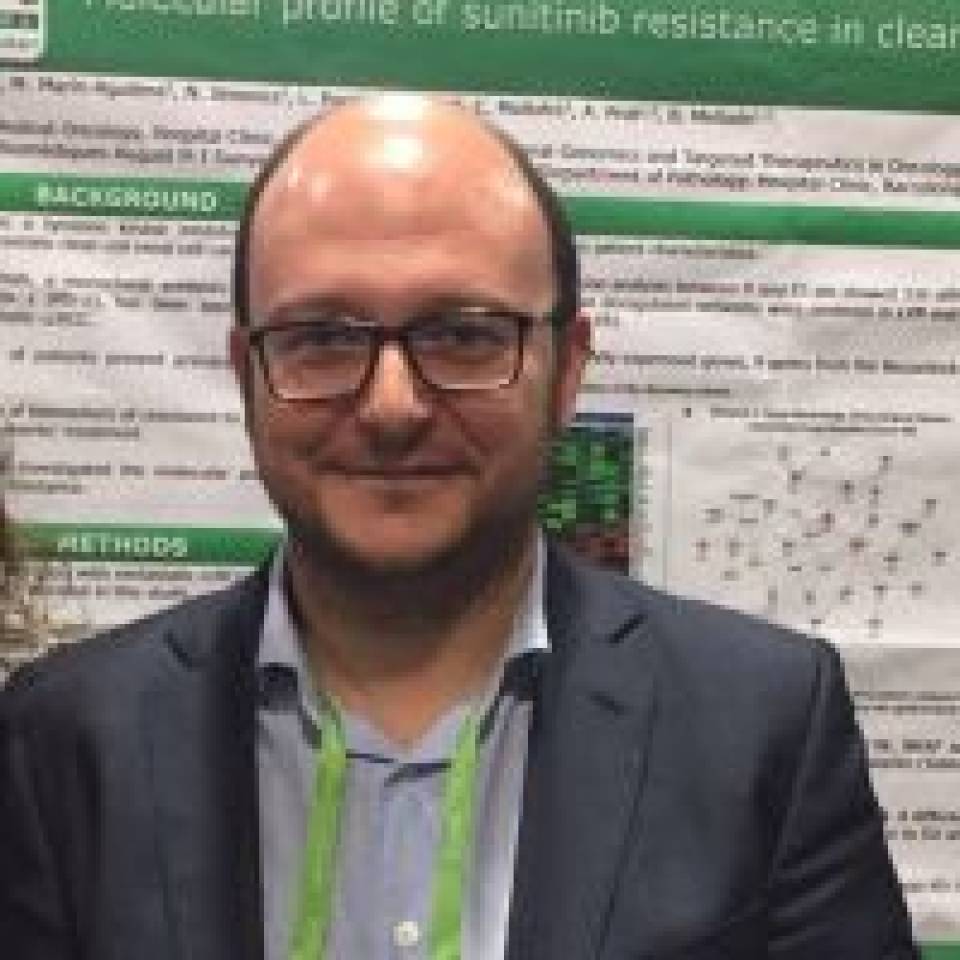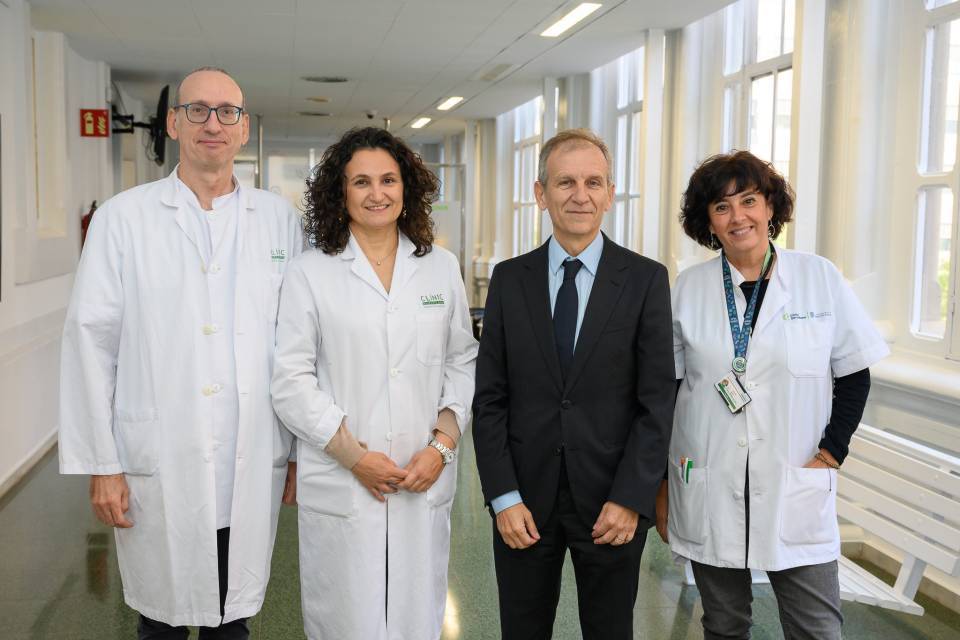- What is it?
- Causes and risk factors
- Signs and symptoms
- Diagnosis
- Treatment
- Living with the disease
- Research
- Frequently Asked Questions
Diagnosis of Prostate Cancer
Not all prostate tumours are equally aggressive. They are classified based on a prostate biopsy, PSA levels, and a digital rectal exam. It is now known that low-risk tumours may behave in an indolent and non-aggressive manner, with a very low risk of spreading to other organs, either from the pelvis or at a distance, and that active treatment is therefore not necessary.
On the other hand, prostate treatments (surgery, radiotherapy, brachytherapy, and cryotherapy) may involve complications that can be quite disabling for the man. In the case of surgery or cryotherapy, these complications are urinary incontinence and erectile problems. For radiotherapy, in addition to these, there may be lesions on the bladder or rectum and the appearance of secondary tumours after some time.
Considering that some prostate tumours are non-aggressive and some prostate treatments have adverse effects, a strategy has been developed where non-aggressive prostate tumours are monitored, to prevent complications in tumours that do not progress and actively treat those that do. This is known as "Active Surveillance".
Active surveillance is the regular monitoring of patients with a prostate tumour who meet certain requirements. Monitoring is carried our through regular PSA analysis and periodic MRI checks on the prostate, as well as prostate biopsies. This requires a high level of patient participation and a willingness to attend the scheduled tests and controls on a regular basis.
In patients where the tumour remains non-aggressive the tumour is monitored, but if the tumour grows or becomes more aggressive, they are offered active treatment, principally surgery or radiotherapy.
Active surveillance may be proposed for patients with non-aggressive prostate tumours willing to be closely monitored. This can prevent or delay the adverse effects of more aggressive treatments without jeopardising the patient’s safety from an oncological point of view.
Prostate cancer treatment depends on its extent and stage.

Radical prostatectomy. This is the removal of the prostate and the surrounding tissues, such as the seminal glands. The bladder is subsequently re-joined to the urethra, known as vesico-urethral anastomosis, where a bladder probe or catheter is put in during surgery. The catheter is a flexible tube that drains urine from the bladder and allows the new join of the bladder with the urethra to heal correctly. The catheter is kept in for about two weeks. This is a standard treatment for localised prostate tumours.
Occasionally, the lymph nodes surrounding the pelvic vessels are also removed. An ilio-obturator lymphadenectomy is performed when there is a risk of involving these nodes, which is measured according to the PSA level and biopsy results, among other parameters.
The operation may involve open or laparoscopic surgery.

Open radical prostatectomy involves making an incision in the lower abdomen. The surgery is performed under general anaesthesia or an epidural to numb the lower part of the body. The patient leaves the operation with a bladder catheter and probably a drain, which is removed in the days following the surgery. The patient usually stays in the hospital for three to five days and leaves with the bladder catheter.

Laparoscopic radical prostatectomy or robot-assisted laparoscopic radical prostatectomy is currently the most commonly used technique. A few small incisions are made in the abdomen through which special instruments and a camera are inserted, to remove the prostate. This is done under general anaesthetic. The advantage of this technique over open surgery is that recovery is faster, with a shorter hospital stay, usually only two days. The bleeding also tends to be less, which helps the patient recover better.
As far as the oncological and functional results are concerned, at the moment the three techniques are comparable.
The risks involved in the different radical prostatectomy techniques are the same as for any major surgery, and include reactions to the anaesthetic, bleeding during surgery, and damage to adjacent organs.
In the postoperative period there may be bleeding, infection of surgical wounds or the formation of blood clots in the legs or lungs, which are usually avoided by taking a course of heparin in the postoperative period, which lasts about three weeks.
In rare cases, it is possible that part of the intestine, specifically the rectum, could be damaged during surgery. This can cause abdominal infections and requires another operation to solve the problem.

Urinary incontinence. Urinary incontinence is the uncontrolled loss of urine or urine leaks during exertion. Normal bladder control and urination are usually restored gradually in the weeks or months after surgery. In general, older patients tend to have more incontinence problems than younger men, and a slower recovery. If the incontinence has not improved or disappeared one year after the surgery, interventions to improve the problem may be considered.

Erectile dysfunction. This is the inability to get a sufficient erection to maintain a satisfying sexual relationship. Erections are controlled by two groups of nerves that run next to the prostate. If the patient does not present erectile problems prior to surgery, and the tumour allows it, an attempt is made to preserve these nerves during the prostatectomy. If the nerves are preserved, erections may be recovered gradually after surgery, but almost all patients have a reduced ability to have erections, something which is greatly influenced by age and previous erectile function.

Focal therapy. This is a surgical treatment that consists of treating only the part of the prostate where the tumour lesion is located, not the whole prostate.
It is a minimally invasive alternative for controlling localised prostate cancer in low or intermediate risk patients, provided they have low PSA levels and the lesion has been located with an MRI.
The idea of focal therapy is to selectively treat the injury observed in the imaging tests and preserve, as far as possible, those functions affected in more radical therapies, such as erectile function and urinary continence.
This type of treatment is currently being developed and experience in it is still limited. It must be performed in centres with a well-established follow-up protocol.
Focal therapy can be performed using various techniques, particularly HIFU and cryotherapy.

High Intensity Focused Ultrasound (HIFU). High intensity focused ultrasound (HIFU) uses high frequency ultrasonic energy to heat and destroy prostate cancer cells. HIFU is newer than other prostate cancer treatments and is used to treat either the entire prostate or only the region affected by the tumour, by performing a focal treatment. Although its use is becoming increasingly widespread, it is necessary to carry out further research to determine the long-term results.
HIFU is indicated for tumours located in the prostate and, particularly, tumours visible in an MRI. It is a minimally invasive treatment involving a short stay in hospital, and the patient can leave the day after the operation.
The procedure is performed under general or spinal anaesthetic. A tube is inserted through the rectum to reach the prostate. The probe emits high intensity ultrasonic energy, which travels through the wall of the rectum into the prostate where the heat kills the tumour cells.
The most common side effects are related to the preservation of neighbouring organs such as the urinary sphincter and erectile nerves. Adverse effects that may occur at an earlier stage are urinary retention, perineal pain, urinary tract infection, haematuria or irritation when urinating.
Long-term adverse effects may include erectile dysfunction, retrograde ejaculation, and stenosis, or narrowing of the urethra.

Cryotherapy. This is a surgical procedure involving freezing and thawing the prostate, causing cell death and the destruction of cancer cells. Cryotherapy is a surgical technique that can be applied in certain patients in the early stages of their disease or in patients who have a tumour recurrence.
To offer this technique as initial treatment, the patients should have small prostates (less than 60 g) and fulfil a series of clinical and anatomopathological criteria.
This technique can also be offered as rescue therapy in patients who have already been treated with radiotherapy or brachytherapy for a prostate tumour and have a recurrence.
This procedure is performed in the operating room under general anaesthetic. A transrectal ultrasound machine is used to place the cryoprobes, through which the prostate is frozen and thawed. At the end of the procedure, a bladder catheter is inserted, which the patient has to keep in for about two weeks. The patient usually stays in the hospital for 24 hours.
Cryotherapy is less invasive than radical prostatectomy surgery because it minimises blood loss and possible complications, but is a treatment that is only offered in certain situations, such as if the prostate is small.
- Erectile dysfunction. The majority of patients have erectile dysfunction after treatment, since the freezing often damages the nerves around the prostate that produce the erection.
- Presence of blood in urine. This is fairly common in the postoperative period and clears up within 24-48 hours of treatment.
- Bladder or rectal irritation. This involves the need to urinate or defecate frequently. This discomfort usually goes away a few weeks after the treatment.
- Injury of the urinary sphincter and subsequent urine leaks. This is rare.
- Fistula (communication) between the urethra and rectum. This occurs in less than 1% of patients and may require surgery.
Radiotherapy and prostatectomy are equally effective, so to choose between them, secondary effects must be considered and evaluated. This requires the knowledge of a uro-oncology surgeon and a radiotherapy oncologist.

Radiotherapy. Radiotherapy damages and kills cancer cells. The cancer cells are less able to recover from the damage caused by radiation than normal cells. It can be done using beams of external radiation or brachytherapy.
External radiotherapy uses high-energy X-rays to destroy cancer cells. Since radiation can also affect cells in neighbouring organs (close to the irradiation zone), such as the bladder, it is important that the radiation beams are precisely directed at the cancer cells, limiting damage to other tissues.
The treatment is painless and applied on a daily basis for seven or eight weeks using specialised equipment. While receiving the radiotherapy sessions, the patient can carry out their daily activities as usual. In the sessions, the patient lies on an examination table for about 20 minutes and receives the treatment. They do not need to be admitted to hospital.
Before starting radiotherapy treatment, a CT scan is necessary to indicate the location of the treatment with small marks on the skin. The healthcare team provides detailed information on what to prepare for the procedure and recommendations on what to eat and drink before each session, to ensure that your bladder is properly filled and your rectum is empty before the procedure.
The CT scan is performed to locate the radiation area, as well as the surrounding tissues that should not be treated. In recent years, the image-guided radiation technique has become widespread. Recent technological development has increased its accuracy and allows a higher dose to be delivered to the tumour, with fewer side effects. For this type of treatment, radiation oncologists locate the prostate very precisely with the help of X-rays or CT scans, to ensure that the radiation is delivered to the prostate.

Altered bladder function. In the short term (during treatment and immediately after completion) many men (60-80%) need to empty their bladder more frequently, especially from the third or fourth week of treatment. Some may also experience discomfort when urinating. These symptoms may last several weeks after the treatment has finished. Bladder catheterisation is rarely needed. In the long term (months or years after external radiation), 2% of patients may present altered urinary function, including obstruction, which can be corrected with surgery. It can also increase the frequency of urination in some patients, while in others it may produce occasional bleeding of the bladder. 1% of men who undergo this treatment may experience urine leaks, especially if they have had an operation prior to the treatment, such as a transurethral resection of the prostate.

Altered intestine function. In the short term, after treatment, the intestines may need to be emptied frequently. Many men (50%) experience some discomfort during bowel movements. These symptoms usually begin between the third and fourth week of treatment and improve a few weeks after it has finished. In the long term, an average of 5% of patients may present moderate rectal bleeding. Normally this problem can be treated with medication. Sometimes, laser therapy may help control the symptoms.

Brachytherapy. In this type of treatment, a source of radiation is introduced directly into the prostate, in other words, radioactive seeds are implanted to eliminate the cancer cells.
Before treatment begins, an ultrasound scan is performed to plan the treatment. The seeds are introduced in an operating theatre in an outpatient surgical procedure. General and, in some cases, epidural or local anaesthetic is usually administered.
Hospital admission is usually not required and the patient may return home after recovery.
The health professional may opt for brachytherapy as one of the options if the patient has suitable characteristics for this: favourable pathological anatomy with a low Gleason score, adequate prostate volume, and an absence of urinary symptoms.
Side effects occur because the organs surrounding the prostate, particularly the bladder and rectum, also receive radiation. These symptoms usually appear by the third week of treatment and disappear some weeks after the therapy has been completed. The treatment may cause fatigue, which is largely due to the daily visits to the hospital for treatment.
Side effects vary from person to person and are related to the general state of health and the type of radiation treatment administered.
A man’s ability to have an erection may be affected, in whole or in part, after treatment. The possibility of becoming impotent as a result of the treatment depends on several factors, including the man’s ability to have erections before treatment, treatment damage to nerves and areas adjacent to the prostate, age, and state of health.

Altered bladder function. In the short term, less than 10% of patients are unable to empty their bladders due to inflammation of the prostate. These patients need a urinary catheter for a few weeks. Almost half of all men need to empty their bladder more often and experience urinary discomfort a week after the procedure.

Altered intestine function. In the short term, there are normally no intestinal problems. In the long term, 1% of patients present rectal bleeding or other symptoms.
In metastatic prostate cancer, other drugs may also be used to control the disease with chemotherapy or radioisotopes.

Chemotherapy. This is the set of drugs that are used to prevent cancer cells reproducing. It can include any drug used to treat cancer, but "classic" chemotherapy involves drugs that act non-specifically against cell division mechanisms, as opposed to hormonal agents or specific drugs that target a particular protein.
For prostate cancer there are two chemotherapies: docetaxel and cabazitaxel. In patients with metastatic prostate cancer, both drugs have been shown to help control the disease. Docetaxel can be administered both in the hormone-sensitive stage of metastatic prostate cancer and in castrate-resistant prostate cancer; cabazitaxel can be used only in castrate-resistance in patients who have previously been treated with docetaxel.
These drugs, like all medicines, may have a number of adverse effects, but they are generally well tolerated and some of the adverse effects can be avoided by observing a few specific recommendations. Both drugs are given intravenously and must be administered by healthcare staff who are specialists in the use of these treatments.
Another pharmacological treatment option is the administration of radium-223. This drug is a radioactive isotope of radium which, due to the way it works, only acts on bone metastases from prostate cancer. Its use is therefore restricted to this type of patients. This drug is also administered intravenously and, due to the way it works, involves a series of recommendations and specific precautions.
The best therapy for each patient is selected based on the efficacy and safety data reported in the literature, together with an evaluation of the patient’s characteristics (general condition, age, other illnesses that preclude the use of certain drugs, etc.) and the qualities of the prostate cancer itself (aggressiveness of the disease, location of metastases, etc.).
Chemotherapy treatments may involve complications and require very close patient monitoring.

Hormonoteràpia. La testosterona és essencial per al creixement i la perpetuació de les cèl·lules tumorals prostàtiques. Els testicles són els majors productors de la testosterona amb una aportació del 90-95% del total, seguit per les glàndules suprarenals. La privació androgènica consisteix en un tractament per reduir els nivells de testosterona. És un tractament important en els pacients amb tumor de pròstata, sent moltes vegades el tractament inicial en aquells casos en què la malaltia ja no està limitada a la pròstata i hi ha metàstasis. També es pot associar a altres tractaments com la radioteràpia.
Androgen deprivation can be performed surgically or with hormone treatment. Currently, hormonal androgen deprivation or hormonal castration is usually performed.
Hormonal castration can be carried out in various ways. Treatment is usually initiated with the association of anti-androgens and LHRH analogues.
Anti-androgens are drugs that attach to the androgen receptors and reduce the action of these cells. They are administered orally, as tablets. Several types of anti-androgens are available, depending on the stage of the disease.
- Bicalutamide. Given in the initial stages of the disease, associated with or prior to the start of the LHRH analogues.
- Enzalutamide. This is a next-generation anti-androgen that is administered in specific instances when treatment with only LHRH analogues is not enough.
They are the initial treatment for metastatic prostate cancers and may also be associated with other therapies. They are given in the form of injectables that last between one and six months.
When administered for the first time, they may lead to exacerbated symptoms. To avoid this, anti-androgens are administered prior to this treatment.
Other next-generation hormonal agents, such as abiraterone and enzalutamide, are also available and these are used in conjunction with the analogues in some cases of disease progression.
- Reduction or absence of sexual desire.
- Erectile dysfunction (impotence).
- Reduction in the size of the testicles and penis.
- Sudden sensations of heat that may lessen or disappear with time.
- Tenderness of the chest and growth of breast tissue.
- Osteoporosis and associated bone fractures.
- Anaemia.
- Decline in mental acuity, tiredness.
- Loss of muscle mass.
- Weight gain.
- Increased levels of cholesterol.
Many of these effects of hormone therapy can be prevented or treated with medication. Physical exercise plays a very important role in reducing the impact of the possible side effects, as it improves, in particular, tiredness and loss of muscle mass.
Despite oncological improvements over recent years, the option of participating in clinical trials should always be considered as a way to gain access to potentially more effective and innovative medication than that currently available. At this time, prostate cancer clinical trials are available that evaluate the use of immunotherapy, drugs that act on molecules involved in the repair of nucleic acids, or other drugs that act on other molecular pathways.
The majority of patients with localised prostate cancer can be cured. Current oncological treatments can significantly prolong life, although it is not always possible to cure the disease. In this situation, more than 80% of patients present intense weakness and more than 70% suffer pain, especially when the prostate cancer affects the bones. Often, the combination of these symptoms in advanced disease causes a progressive functional deterioration. The integrated approach to the patient takes into account both the specific tumour treatment and the symptoms it causes.
The suffering of the patient with advanced cancer is a complex life experience that integrates both the physical symptoms and the emotional impact of the disease, as well as family and social aspects. Adequate treatment of the symptoms and good psychosocial support can help the patient adapt to the disease and reduce their suffering.
Palliative care is defined as active and comprehensive healthcare aimed at improving the quality of life of patients with advanced diseases that cannot be cured. Palliative care encompasses the treatment of pain and physical symptoms, psychological support, and social support.
This service can be offered, if necessary, in the initial stages of the disease together with the specific treatments used to attempt to control the cancer.
Palliative care teams are multidisciplinary and usually made up of doctors, nurses, psychologists, and social workers with specific training, who work in coordination with healthcare professionals at all levels, whether in hospitals or primary care centres.
After evaluating the clinical situation and symptoms (physical symptoms, cognitive state, functional status, emotional impact, coping strategies and social-family support), the palliative care team establishes a care plan in conjunction with the other healthcare professionals who are treating the patient. The objectives of this care plan are to control the symptoms, prevent and treat medical complications, preserve the patient’s functional and mental state as much as possible, encourage emotional adaptation and coping strategies, support the family care structure, promote autonomous decisions and advance directives in the end-of-life process, and ensure a peaceful death in the event that this is unavoidable.
Substantiated information by:







Published: 6 May 2019
Updated: 6 May 2019
Subscribe
Receive the latest updates related to this content.
Thank you for subscribing!
If this is the first time you subscribe you will receive a confirmation email, check your inbox
